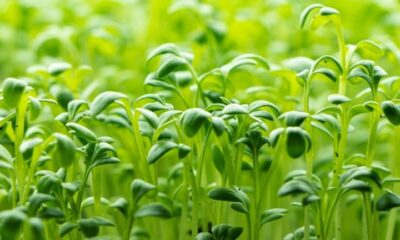
Shutterstock
Gardening is like therapy, but with dirt. Whether you’re growing your own veggies or just making your backyard pretty, there’s something incredibly satisfying about getting your hands dirty. It’s good for your plants and your mind, body, and soul (and let’s be honest, it’s a great excuse to avoid chores). Plus, with so many online gardening communities, you’re never alone, unless you’re talking to your plants (no judgment). So grab a shovel, roll up your sleeves, and let’s dig into the wonderful world of gardening!
Choose a suitable location

Shutterstock
Selecting the right location is crucial for your garden’s success. It determines how much sunlight and shade your plants will receive, which affects their growth. Consider factors like wind exposure and proximity to water sources. A little research on your plant varieties will help you choose the perfect spot.
Start with easy-to-grow plants

Shutterstock
If you’re new to gardening, begin with plants that are known for being easy to care for. These include varieties like tomatoes, sunflowers, and lettuce. They’ll give you a chance to build confidence before tackling more demanding plants. Success with these will inspire you to grow more diverse plants in the future.
Use quality soil

Shutterstock
Healthy plants start with healthy soil. The quality of soil directly influences the nutrients available to your plants, which can determine their growth and productivity. Invest in good-quality soil or amend your existing soil with compost or organic material. Well-drained soil is essential for strong root development and plant health.
Invest in basic gardening tools

Shutterstock
Having the right tools makes gardening easier and more enjoyable. Invest in a good set of basic tools like a trowel, pruners, a hoe, and a watering can. These tools will help you with planting, pruning, weeding, and maintaining your garden. Quality tools can last for years, making your gardening experience more efficient and rewarding.
Learn about your local climate

Shutterstock
Understanding your local climate is key to successful gardening. Local weather patterns, including rainfall, temperature ranges, and frost dates, play a significant role in what plants will thrive. Research your USDA hardiness zone and choose plants suited to your climate. This will ensure that your garden flourishes in the long term.
Start small

Shutterstock
It’s easy to get excited about gardening, but starting with a small plot can be more manageable and less overwhelming. You can always expand later once you gain more experience. Starting small also helps you learn the basics without feeling pressured. It’s better to start with fewer plants and succeed than to have too many plants and struggle.
Grow what you like to eat

Shutterstock
One of the most rewarding aspects of gardening is growing your own food. If you love fresh tomatoes, herbs, or peppers, plant those first. This ensures you’re invested in caring for your plants and excited about the harvest. Plus, growing your favorite foods will make meals even more satisfying.
Use raised garden beds

Shutterstock
Raised garden beds offer several advantages, especially for beginners. They improve drainage, reduce soil compaction, and make gardening easier on your back. Raised beds also warm up quicker in the spring, which can extend your growing season. They’re ideal for growing vegetables, herbs, and flowers.
Plan your garden layout

Shutterstock
Proper garden planning ensures that your plants have the right space to grow and thrive. Sketch out your garden layout before planting to optimize the space. Consider plant heights, sunlight needs, and water requirements when planning. A well-thought-out layout reduces the chance of overcrowding and helps with plant maintenance throughout the season.
Mulch to retain moisture

Shutterstock
Mulching around your plants is an effective way to conserve moisture and improve soil quality. Organic mulches, like wood chips or straw, break down over time, enriching the soil with nutrients. It also prevents weed growth and regulates soil temperature. A good layer of mulch helps keep plants hydrated during hot, dry spells.
Water early in the day

Shutterstock
Watering early in the day gives your plants the best chance to absorb moisture before the heat of the afternoon. It also reduces the likelihood of disease by allowing the foliage to dry out. Early watering also conserves water as there is less evaporation compared to midday. This helps ensure your plants stay healthy and hydrated throughout the day.
Compost kitchen scraps

Shutterstock
Composting kitchen scraps is a sustainable way to enrich your garden soil. Food waste like vegetable peelings, coffee grounds, and eggshells can be turned into nutrient-rich compost. This helps improve soil structure, increases organic matter, and reduces waste. Composting not only benefits your garden but also reduces the need for synthetic fertilizers.
Rotate crops annually

Shutterstock
Crop rotation is important for maintaining healthy soil and preventing pest buildup. By changing the types of plants you grow in a given spot each year, you reduce the risk of diseases and nutrient depletion. It also encourages biodiversity, which can help improve pest control and soil health. Implementing crop rotation will lead to better yields and healthier plants in the long term.
Use natural pest control

Shutterstock
Instead of relying on chemical pesticides, try using natural pest control methods. Companion planting can deter harmful insects, while beneficial insects like ladybugs can help control pests. You can also use organic sprays made from neem oil or insecticidal soap to protect your plants. These methods are safer for the environment and your garden’s health.
Learn about companion planting

Shutterstock
Companion planting involves growing plants together that benefit each other. Some plants can repel pests, while others can enhance growth or improve flavor. For example, planting basil near tomatoes can improve their flavor while keeping pests away. Understanding the relationships between plants can create a healthier, more productive garden.
Regularly weed your garden

Shutterstock
Weeding is an essential part of maintaining a healthy garden. Weeds compete with your plants for nutrients, water, and sunlight. Regularly removing weeds will prevent them from overtaking your garden and help your plants grow stronger. Hand-pulling or using mulch can prevent weeds from spreading.
Prune plants for better growth

Shutterstock
Pruning helps your plants grow healthier by removing dead or damaged growth. It also encourages better air circulation and more sunlight penetration. Proper pruning can also improve the shape and size of your plants, leading to stronger growth and better fruit or flower production. Always use clean, sharp tools when pruning to avoid damaging your plants.
Label your plants

Shutterstock
Labeling your plants helps you identify them more easily and track their growth. It’s also a great way to remember which plants need specific care. Use plant markers or tags to note varieties and planting dates. Labeling makes it easier to care for your garden and keeps you organized.
Research plant care needs

Shutterstock
Every plant has different care requirements. Some plants need full sun, while others thrive in shade. Make sure you research each plant’s specific needs regarding water, nutrients, and temperature. This knowledge will help your garden thrive and prevent issues caused by neglecting these requirements.
Use organic fertilizers

Shutterstock
Organic fertilizers are a great way to nourish your garden without harming the environment. They provide essential nutrients for plant growth and improve soil health. Organic options like compost, manure, or fish emulsion work slowly, providing a steady supply of nutrients over time. These fertilizers help your plants grow strong and vibrant while keeping harmful chemicals out of your soil.
Protect plants from frost

Shutterstock
Frost can damage or kill tender plants, so it’s essential to protect them during cold spells. Use frost covers, cloches, or row covers to shield plants from freezing temperatures. You can also bring potted plants indoors or move them to a sheltered location. Protecting your plants from frost ensures they continue growing strong during colder months.
Keep a gardening journal

Shutterstock
A gardening journal helps you track your gardening progress and plan for the future. Document planting dates, growth patterns, and any problems you encounter. It’s also a great place to note successes, like the first bloom or harvest. This journal will serve as a useful reference in future gardening seasons.
Observe sunlight patterns

Shutterstock
Understanding the sunlight patterns in your garden helps you choose the best spot for each plant. Most plants require at least 6 hours of direct sunlight per day, while others thrive in partial shade. Observe the areas of your garden throughout the day to determine which spots are sunnier or shadier. This will guide your planting decisions and ensure optimal growth.
Join a gardening community

Shutterstock
Joining a gardening community can be incredibly helpful for beginners. You can share advice, exchange tips, and ask for help when needed. Many local communities have gardening clubs, online forums, or social media groups where you can connect with fellow gardeners. Building relationships with others who share your passion can make gardening more enjoyable and less stressful.
Enjoy the process!

Shutterstock
Gardening is a journey, not a race. Don’t stress about perfection, and remember to enjoy the process. Celebrate small victories like your first sprout or the first bloom. Take time to appreciate the beauty and tranquility your garden brings into your life.
Conclusion

Shutterstock
Remember, gardening is a journey, not a race. From picking the perfect location to chatting with your houseplants, there’s always something new to learn. So, don’t be afraid to get your hands dirty, after all, they say dirt is just a layer of life’s little surprises. Now go out there, grow some green, and maybe even make a new plant friend or two!





















































